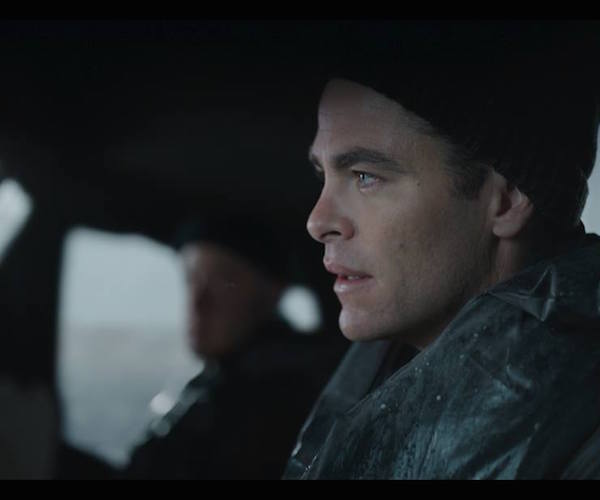Fuse Film Review: “The Finest Hours” — Enjoyable, Reliable, Predictable
The Finest Hours gives the audience two hours of fast moving, visually pleasing, easily digestible entertainment.
The Finest Hours, directed by Craig Gillespie. At AMC Assembly Row, Somerville Theatre, Apple Cinemas Cambridge

Chris Pine in a scene from “The Finest Hours.”
By Paul Dervis
In The Finest Hours, Disney does what Disney does best. It gives the audience two hours of fast moving, visually pleasing, easily digestible entertainment. The point is that you don’t have to think too much. The good people are sweet and humble, and the darker characters are misguided but redeemable. And everyone will be happy in the end.
At least this film is never boring. And it’s a true story.
Chock-full of powerful, yet realistic, special effects, The Finest Hours establishes a New England blizzard that those who live in the area will recognize. The rolling waves off the coast of Chatham, MA are awe inspiring, but not ridiculously so. The snowfall on Cape Cod is probably equivalent to what we are experiencing this week. The images grip us, but do not suggest Armageddon. The folks at Disney usually know better than that.
It’s 1951. Young Bernie Webber is a Coast Guard shipman who has fallen in love with a telephone operator named Miriam. She is a brassy lass who knows what she wants and she wants Bernie. But the sailor is not a confident fellow. Shy, awkward, and living with the awareness that he may go out on a mission and not return, Bernie reluctantly agrees to marry her as long as his supervisor at the Coast Guard Station gives his blessing. It apparently is an unwritten rule to get your boss to sign off on marriages, and Bernie is a good company man.
But, before he can ask his superior, a hellacious storm rolls in off the coast and batters a tanker. A highly experienced crew goes out to save the ship, leaving only the young pups behind. Soon after that emergency, another oil tanker, the Pendleton, is literally ripped in half, stranding some thirty odd crewmen, who are left helplessly clinging to the remnants of the boat. So the young guns are sent out on an apparent suicide mission. They don’t have time to go around the Chatham Bar — they must go through it and the enormous waves generated by the storm.
It is a mission that Bernie failed at the year before, and a beloved local sailor died because of that failure.
But this time would be different.
The scene of the small rescue boat attempting to traverse the bar and the gigantic waves is the most impressive and dramatic sequence in the film. It is breathtaking, but not over the top. One is convinced that this kind of storm actually looks like this out at sea. In fact, all of the special effects are effective. Seeing the half demolished tanker — massively standing strong while being battered by the ocean — is striking, yet believable.
The cast did what would be expected in a feel-good adventure movie; nothing more, nothing less. Chris Pine (Star Trek, People Like Us) was convincingly humble while remaining as cute as a button. And he was convincingly single-minded in his resolve to beat the odds and save the sailors. He even showed fear in the face of his intimidating task.
As Miriam, Holliday Grainger (Cinderella, Great Expectations) comes off as a veritable Cupie doll. With bright eyes and round face, she looked soft as silk but displayed plenty of tough-as-nails determination. Of course, she did. We have seen this kind of never-say-die character a hundred times before.
And Casey Affleck, the captain of the tanker, was suitably stalwart as the white collar leader of the motley blue collar crew. The longer he faced down the crisis, the more respect he garnered from his minions.
This movie was, to a great extent, filmed in Chatham. The views of the region are not just recognizable, but compelling. To the point that it makes one want to visit in the winter. And if you go to productions at local theater stages, you may well see familiar faces…plenty of small parts are filled out from the Boston acting community.
Still, this is a throwback film. Dozens of them were made in the decade following World War II. If it had been made back in that era, The Finest Hours would have starred Audie Murphy and Robert Ryan. The formula still works. Don’t go into the cinema expecting much more than standard macho fare and you will be pleasantly surprised.
It never drags and it doesn’t indulge in too much overkill — and in today’s Hollywood, you can’t expect much more.
Paul Dervis has been teaching drama in Canada at Algonquin College as well as the theatre conservatory Ottawa School of Speech & Drama for the past 15 years. Previously he ran theatre companies in Boston, New York, and Montreal. He has directed over 150 stage productions, receiving two dozen awards for his work. Paul has also directed six films, the most recent being 2011’s The Righteous Tithe.
Tagged: Casey Affleck, Chris Pine, Coast Guard, Craig Gillespie, Disney, Paul Dervis
